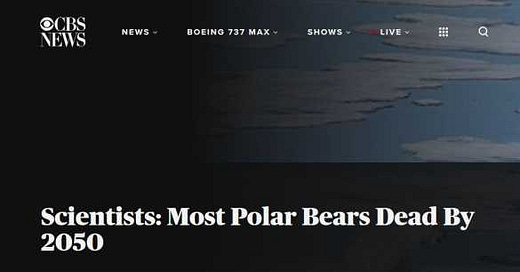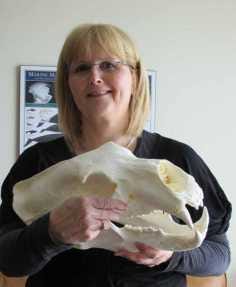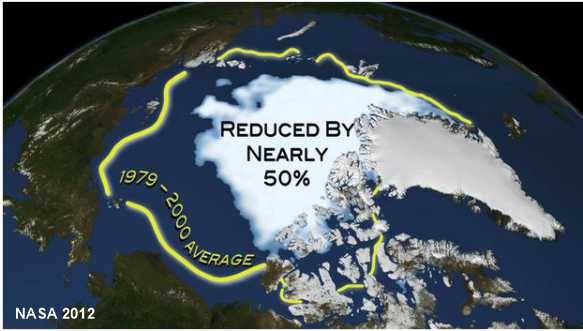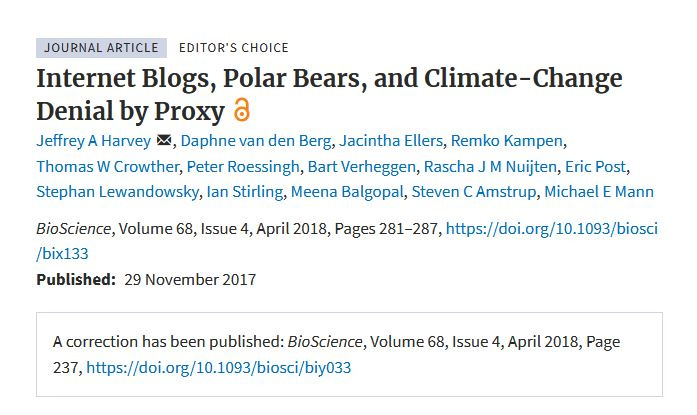Holding Polar Bear Specialists to Account Part 1
Challenging the extraordinary claims of polar bear specialists has been a huge part of my life for more than a decade but it cost me
It began in late 2006 when I received a request from Library of Congress researcher Eugene Buck to review the draft of a document he’d prepared as background for the up-coming vote on the listing of polar bears as “threatened” under the Endangered Species Act. This proposed ruling was based on predicted effects of future carbon-dioxide levels blamed on human fossil fuel use, something the ESA had never considered before.
My work on domestication as a speciation process examined polar bears as an excellent example of a contrasting wild species that arose rapidly under natural conditions. This meant I’d already spent years reading up on polar bears and their Arctic sea ice habitat.
My Pacific ID colleagues agreed that as a public service, the company would pay me to work on improving Buck’s draft, which was supposed to be complete and unbiased but was neither of those things.
I was please to see that the finalized document incorporated most of my suggested additions and had taken it from four pages of text to 10 pages of text plus a map.1
The exercise made me realize I could improve the quality of information available to the public, other scientists, and policy makers, which they’d need moving forward while evaluating the near-constant barrage of doomsday messaging regarding polar bear health and survival.
In 2008, I used the information I’d learned from my Library of Congress research to create a short summary document of my own called, “What We Know – and Don’t Know – About Polar Bears” that I shared online with established bloggers writing about climate change.
Eventually, in 2012, I started my own blog where I write about various topics relevant to polar bears and Arctic ecology with a focus on evidence from the past and present. This includes reviews of newly-published papers and critiques of news items, as well as reviews of papers published decades before the current obsession with global warming had taken hold.
On occasion, PolarBearScience also deals with claims of walrus and penguins being victims of climate change, since they’re issues of a similar nature.
By 2016, I felt there was enough evidence to formally challenge the dire prediction made by polar bear researchers at the US Geological Survey in 2007. I observed that their proposal could be treated as a testable hypothesis, since they’d explicitly stated that if summer sea ice extent declined rapidly to 3-5m square kilometers in 4 out of 5 years (or 8/10), two-thirds of the world’s polar bears would disappear.2
Sea ice models predicted these ice conditions by 2050, but by 2012 that requirement had been met but without widespread death of bears.
I submitted a scientific paper for review. One reviewer (almost certainly a polar bear specialist) suggested I’d been paid to write the paper and therefore lied about having a conflict of interest. The other reviewer (a mountain goat researcher) said the failed hypothesis portion was interesting and worth rewriting, so I did.
The revised manuscript was rejected outright, so I sent it out myself to several knowledgeable colleagues for review — including an unbiased polar bear specialist — revised it accordingly, and submitted it in early 2017 to a pre-print publisher.3
[By September 23, 2024, the paper had been downloaded almost 7,000 times.]
I know that my assessment had the support of other biologists because they wrote to tell me so. In 2018, respected ecologist Valerius Geist suggested we co-author a short summary of this paper as an article for Range Magazine.4
However, that fall, the two polar bear specialists who’d felt most slighted by my critique – Ian Stirling and Steven Amstrup – went on the attack. Amstrup’s personal opinions about how polar bears would respond to future challenges had been used exclusively in the USGS models used to predict whether polar bears could survive predicted changes in sea ice coverage.5
Understandably, Amstrup took my criticisms personally but instead of dealing with this as a scientific dispute, he and Stirling went for defamation by libel.
They teamed up with 12 other academics, including several who had been out-spoken global warming promotors – including Stephan Lewandowsky, Jeff Harvey, and Michael Mann – and wrote a paper that slammed my reputation and integrity. It was published online November 29 in a journal called BioScience that’s aimed at teachers and students, and critically, is available at public libraries.6
Here’s a quote from a long summary essay I wrote on my blog in April 2018:
The Harvey paper neglected to include the fact that I am a professional zoologist with four decades of pertinent experience. They left out the fact that I have a Ph.D. and many peer-reviewed papers on a variety of topics including Arctic ecology and evolution of Arctic species. They refer to me as a "blogger" as if that were my only credential, when it is precisely because I am so well qualified to critique the work of polar bear scientists that they feel a need to trash my reputation. …
Media coverage of this paper was enormous and quite out of proportion to its significance. That's because three – yes three – press releases were issued by the various institutions at which co-authors are employed. Read releases here, here, (as pdf) and here.
Only one journalist contacted me prior to the embargo being lifted on the paper, which was the only reason I knew about it a few hours prior to publication.
For example, the headline from MotherBoard, read:
80 percent of climate denier blogs reference this one Canadian zoologist: A University of Victoria adjunct prof has become climate deniers’ go-to source on polar bears.
The paper is atrocious on all kinds of levels. Respected climate scientist Judith Curry, Emeritus Professor of Earth and Atmospheric Sciences at Georgia Institute of Technology, tweeted that it was “…absolutely the stupidest paper I’ve ever seen published.”
Richard Tol, a well-credentialed economics professor and data analyst at the University of Sussex, wrote a scathing critique which BioScience refused to publish.7
For a couple months afterwards, internet blogs of all stripes were buzzing with the controversy. Many of these racked up hundreds and hundreds of comments, the like of which I’d not seen before.
In April 2018, the New York Times weighed in when the print version of the paper came out and I faced another round of public and online abuse. The summary essay quoted from above, was my response.
Although this unprofessional attack had the intended consequence of providing “evidence” the legacy media could use to justify never again citing or quoting me on polar bear issues, the BioScience bully squad failed to take into account the burgeoning power of social media, search engines, and citizen journalism. They were able to limit my reach but not silence me.
That week in late November/early December of 2017, my blog got more views and new followers than at any time since 2012, when I’d started it up.
And unfortunately for Amstrup and Stirling, their timing was bad. A week later, National Geographic released their block-buster video of a starving polar bear they claimed was “what climate change looks like,” and even more people flocked to my site. I published evidence that one starving bear is not proof of climate change and exposed the NG video as manipulative tragedy porn.
Six months later, the accumulated backlash worldwide was so severe NG was forced to walk back its claim. See my video, “White Lie: The Cruel Abuse of a Starving Polar Bear [>110 thousand views at 24 Sept 2024]
In summary, November 2017 to 2018 was an eventful year but 2019 proved to be even more so.
To be continued…
Buck, E.H. (2007). Polar bears: proposed listing under the Endangered Species Act [March 30], Oder code RL33941, 11 pg., 1 map. https://digital.library.unt.edu/ark:/67531/metadc821468/ and https://www.everycrsreport.com/files/20070330_RL33941_bdf7bec99a7d3ea88354f0f11951354333edfc20.pdf
Hunter, C.M., Caswell, H., Runge, M.C., et al. (2007). Polar bears in the southern Beaufort Sea II: demography and population growth in relation to sea ice conditions, 2001-2006. Administrative Report US Geological Survey, Reston, VA. Pdf here.
Crockford, S.J. (2017). Testing the hypothesis that routine sea ice coverage of 3-5 mkm2 results in a greater than 30% decline in population size of polar bears (Ursus maritimus). PeerJ Preprints 2 March 2017. Doi: 10.7287/peerj.preprints.2737v3 Open access. https://doi.org/10.7287/peerj.preprints.2737v3
Crockford, S.J. and Geist, V. (2018). Conservation Fiasco. Range Magazine, Winter 2017/2018, pg. 26-27. Pdf here. Open access.
Amstrup, S.C., Marcot, B.G. & Douglas, D.C. (2007). Forecasting the rangewide status of polar bears at selected times in the 21st century. US Geological Survey. Reston, VA. Pdf here
Harvey, J.A., van den Berg, D., Ellers, J., Kampen, R., Crowther, T.W., Roessingh, P., Verheggen, B., Nuijten, R. J. M., Post, E., Lewandowsky, S., Stirling, I., Balgopal, M., Amstrup, S.C., and Mann, M.E. (2017). Internet blogs, polar bears, and climate-change denial by proxy. Bioscience, 68 (4), 281-287. https://doi.org/10.1093/biosci/bix133 Open Access, available here. Supplementary data file available here and the data for the principal component analysis is available here and (h/t to R. Tol), the R code is available here Corrigendum here (issued 28 March 2018).









I have now read every thing referred to here. I have also read : “The 2024 state of the climate report: Perilous times on planet Earth” and am on-side with it. I have read another book, however, which seems relevant to this discussion: The Scottish Witch-hunt in context, edited by Julian Goodare (2002). I find it relevant here to quote from a passage of Stuart McDonald’s: In search of the Devil in Fife witchcraft cases, 1560-1705. In regard to witches, it was summarised:
“In the godly society which the Church was trying to create and which other members of the elite supported, any powers to harm or heal belonged only to God and could only be explained only by the church. To this enterprise, the Devil or a demonic pact were not required to make her an enemy or a threat; she was a threat by her very existence.”